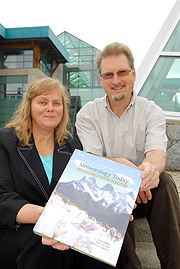UNBC Faculty Publish First Canadian Weather Textbook
August 17, 2011
Growing frustration with American textbooks among Canadian students and instructors has led a husband and wife team at the University of Northern British Columbia to produce the first-ever weather textbook specifically aimed at Canadian students. UNBC Environmental Science Professor Peter Jackson and spouse Chris, a Geography Senior Lab Instructor, have adapted a popular US textbook to address concerns that Canadian weather systems and methods are underrepresented and misunderstood. “Weather doesn’t end at the 49th parallel, but if you read most North American meteorology texts, you might believe that it does,” says Chris. “Students are becoming increasingly frustrated with not having Canadian weather phenomena and methods represented and faculty are tired of saying ‘what your text says is true, but in Canada we do things differently.’” The first Canadian edition of Donald Ahrens’ Meteorology Today: An Introduction to Weather, Climate, and the Environment is published by well-known Canadian educational publisher, Nelson. In addition to a Canadian perspective, it features contributions from 19 researchers, educators, and meteorologists from across Canada, including CBC broadcast meteorologist Claire Martin. “American textbooks often present snow as an uncommon and somewhat unusual phenomenon,” says Peter, “Of course, Canadians know this isn’t so! This is just one example of how meteorology differs between the two countries. We analyze fronts, air masses and stability differently and use different types of maps and data. Also, Environment Canada works differently than the U.S. National Weather Service, so this adaptation is much more than just ‘the US measures in miles and Canada uses kilometres.’” When Nelson first approached Peter to produce the work in order to fill the growing demand for Canadian content in textbooks, he knew Chris would be an ideal collaborator. “With her background as a physical geographer, lab instructor, and education specialist, she is more in tune with introductory students and how to make ideas more accessible to them,” says Peter. “An example of this is a feature at the start of each chapter that uses graphics and words to relate weather topics in the chapter to the big picture. This helps students see weather in the context of its role in the Earth-Atmosphere system.” The book has been adopted by university classrooms across Canada and will be used by UNBC students starting in January. | Media Downloads Click on a thumbnail to access a high resolution image. |

